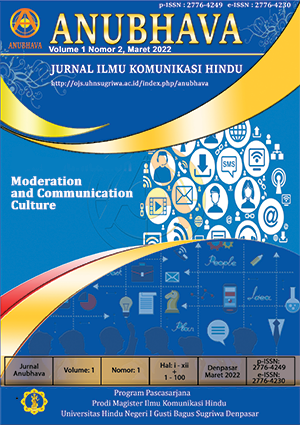KOMUNIKASI ANTAR BUDAYA MASYARAKAT HINDU-MUSLIM DALAM MENJAGA KERUKUNAN UMAT BERAGAMA DI DESA SINDUWATI KECAMATAN SIDEMEN KABUPATEN KARANGASEM
DOI:
https://doi.org/10.25078/anubhava.v2i1.674Abstract
Communication in this study is defined as a meeting between several religious cultures in an area, both communication that takes place in one direction and two-way communication that depend on each other. This communication later forms a formula, a pattern that is carried out by the community in responding to the various cultures that are carried out by each of them. The application of this multicultural concept can be taken as an example to the Hindu community in Sinduwati Village, Sidemen District, Karangasem Regency, which can impact multiculturalism in real life, in its concrete form, namely the existence of cultural communication between the Hindu community and the Muslim community in the village. This can be seen from the way they parallel and respect other teachings openly.
This research was conducted in Sinduwati Village, which is located in Sidemen District, Karangasem Regency. His writing is limited to Intercultural Communication of Hindu-Muslim Community in Maintaining Religious Harmony. This study used a qualitative-descriptive type of research. Descriptive research is generally carried out with the main objective of systematically describing the facts and characteristics of the object or subject being studied appropriately. Data were analyzed by carrying out a series of activities, namely data reduction, presenting, and drawing conclusions. The three steps, both reduction, presentation and conclusion are steps that are integrally interrelated as an analysis circle so that finally the analyzed data can be presented as a research report.
Hindu-Muslim Cultural Communication in Sinduwati Village, related to every religious believer should fully believe and fully trust the truth of the religion he embraces. Religion is able to act as a tool to build solidarity as well as high loyalty for its adherents. Plurality is something that cannot be denied or avoided anywhere and by anyone. The number of Muslim population in Sinduwati Village is relatively small (minority) but the people of Sinduwati Village have never carried out activities that deserve to be said to injure inter-religious harmony between Hindus and Muslims that has existed for a long time. The ancestors of the Hindus in the village of Sinduwati believed that this difference was a gift from God, considered as one of the manifestations of the teachings of God in their respective religions.
Keywords: Intercultural Communication, Hindu-Muslim Society, Maintaining Religious Harmony
References
Antaranews.com. 2021. Indeks Kerukunan Umat Beragama. https://www.antaranews.com/berita/815228/litbang-kemenag-indeks-kerukunan-umat-beragama-2018-turun (diakses tanggal 20 April 2021)
Budiasa, I. M. (2015). Kontestasi Ideologi Gerakan Spiritual Sai dalam Budaya Hindu-Bali. VIDYA SAMHITA: Jurnal Penelitian Agama, 1(2).
Budiasa, I. M. (2019). Representasi Wacana Tanpa Kekerasan di Cybermedia dalam Praksis Budaya Hindu-Bali: A Critical Discourse Analysis. VIDYA SAMHITA: Jurnal Penelitian Agama, 5(2).
Kartika, N. G. A., & Budiasa, I. M. (2019). PROSESI TRADISI NGAMBENG DALAM UPACARA DEWA YAJNA DI PURA SAMUANTIGA DESA BEDULU. VIDYA SAMHITA: Jurnal Penelitian Agama, 5(2).
Koentjaraningrat, 1997. Antropologi Budaya. Jakarta: Dian Rakyat.
Kompasiana, 2021. Multikulturalis Indonesia. https://www.kompasiana.com/bambangjes/54f43164745513a22b6c862b/multikulturalisme-indonesia (diakses tanggal 3 Maret 2021)
Nurasa, I Wayan, 2007. Interaksi Umat Hindu dan Islam dalam Kehidupan Masyarakat Desa Sinduwati wati (Perspektif Tri Hita Karana). Tesis Program Pasca Sarjana IHDN Denpasar.
Ritzer, George, 2004. Teori Sosial Postmodern. Yogyakarta: Kanisius.
Downloads
Published
Issue
Section
License
Copyright (c) 2022 Anubhava: Jurnal Ilmu Komunikasi HIndu

This work is licensed under a Creative Commons Attribution-NonCommercial-NoDerivatives 4.0 International License.
Anubhava: Jurnal Komunikasi Hindu is licensed under a Creative Commons Attribution-ShareAlike 4.0 International License. Permissions beyond the scope of this license may be available at Anubhava: Jurnal Ilmu Komunikasi
















